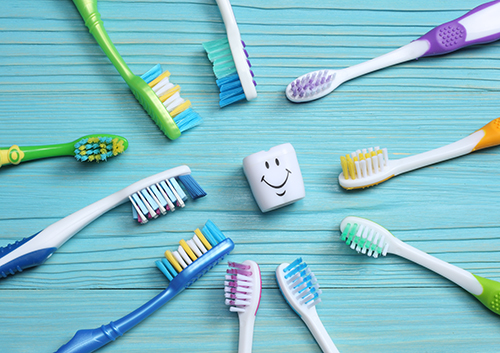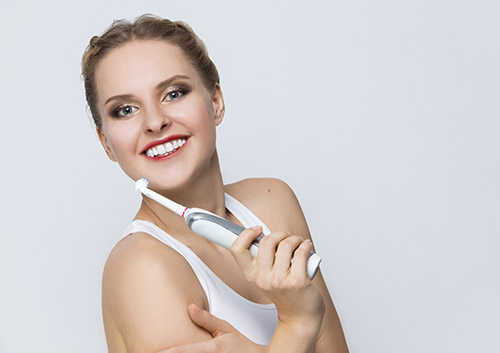Treating Gum Disease with Antibiotics
April 20th, 2022

For those of our patients at High Point Dental Group who suffer from periodontal (gum) disease, we proudly offer topical or oral antibiotics to help reduce or entirely eliminate disease-causing bacteria. It can also help fight the bacterial infection causing gingivitis, a mild form of periodontal disease that is characterized by reddening, swelling, and bleeding of the gums.
Drs. Angela Paros, Amer Atassi, Eric Young, Alexander Katsnelson may recommend systemic or topical antibiotics in conjuncture with scaling and root planing, as well as other procedures. These antibiotics include:
- Tetracycline: The primary drugs used in the fight against bacteria, tetracycline includes antibacterial properties which help reduce inflammation and block collagenase, a protein which destroys the connective tissue and bone.
- Azithromycin: This antibiotic is known to reduce bacterial growth associated with periodontitis, and is regularly used to reduce inflammation in those patients who are heavy smokers.
- Metronidazole (Flagyl): This antibiotic may be prescribed to those patients suffering from severe periodontitis. Metronidazole works best when used in a combination with amoxicillin or tetracycline.
- Ciprofloxacin: This antibiotic is used to specifically target A. actinomycetemcomitans, a slow-growing but harmful bacterium that contributes to gum disease.
- Amoxicillin: Only intended to fight bacteria and bacterial infections, amoxicillin does not kill bacteria but prevents microbes from forming walls that surround them, which is how bacteria reproduces and survives.
- Clindamycin: An antibiotic that works by stopping the development of bacteria, clindamycin is used to treat a variety of serious bacterial infections.
Most forms of gum disease can be treated without antibiotics, but the biggest advantage of using topical antibiotics to help treat the disease is that they are directed to their specific target areas, thus the entire body is not affected. The other advantages of topical antibiotics include reduced dosage and reduced side effects. Drs. Angela Paros, Amer Atassi, Eric Young, Alexander Katsnelson can discuss with you the advantages, as well as side effects, of each antibiotic during your visit.
To learn more, or to schedule your next visit at High Point Dental Group, please give us a call today at our convenient Romeoville, IL office!
Seven Ways to Repurpose Old Toothbrushes
April 13th, 2022

It’s done a wonderful job for you, but after three or four months, the time has come to retire your toothbrush. Bristles that once easily removed food particles and plaque have become frayed and just aren’t as effective. But now that you’re regularly changing out your toothbrush, what to do with those retired brushes besides add to the local landfill? Check out some recommendations from Drs. Angela Paros, Amer Atassi, Eric Young, Alexander Katsnelson for some second career options for that old toothbrush.
Make Your Jewelry Shine
A gentle brush with your favorite jewelry cleaner and your old brush will remove dirt from small spaces and filigree that a cloth just can’t reach. Do check that brushing is safe for your jewelry—pearls, for example, are not a good candidate.
Keep Your Woodwork Dust-free
Keep the details on your wood trim dust free with an old toothbrush. Baseboards are some of the hardest places to keep clean—even vacuums have difficulty getting dust and dirt out of trim. But an old toothbrush is perfect for cleaning the top, the grooves, and the inside corners of your baseboards. You can also remove dust from around door trim and inside window tracks.
Polish Sinks and Faucets
Use a repurposed toothbrush to remove build-up where the base of your faucet meets the sink, or around levers and handles. And don’t forget the metal ring around the drain!
Clean Kitchen Gadgets
Those miniature blades in your coffee maker or blender, the tiny holes in your cheese grater, the micro-openings in your microplane—small cleaning jobs need small tools! Try an old brush the next time you have a mini-cleaning problem.
De-grease Appliances
And while we’re in the kitchen, don’t forget your appliances. A toothbrush can clean grease around dials, handles, and knobs where a sponge can’t reach.
Refresh Your Grout
There are special brushes made just for scrubbing grout, but give your old brush a try first. Use your regular cleaning solution or paste for fresh, clean grout lines on your tile floors and counters.
Keep Your Technology Sleek
Your keyboard has a busy life and it shows! Keep the spaces between your keys dust and crumb free with a clean, dry toothbrush. The next time you’re detailing your car’s interior, try a toothbrush for cleaning around buttons and dials on your dash. And don’t forget your remote controls, or any other place where keys, knobs, and buttons collect dust.
There’s still a lot of life left in that toothbrush! If you choose to reuse, do be sure to thoroughly clean your toothbrush before it transitions to another housekeeping detail. It’s worth the effort—your old brush will prove useful in any number of new ways, and your home—and the environment—will thank you!
When should I see a periodontist?
April 6th, 2022

There are several conditions that might require a visit to the periodontist. Periodontists like Drs. Angela Paros, Amer Atassi, Eric Young, Alexander Katsnelson are specialists in the treatment of gum disease and problems affecting the tissue surrounding the teeth. Your general dentist might recommend seeing a periodontist for any of these conditions:
- Early signs of periodontal disease
If you notice that your gums are red or swollen, or if you see bleeding when you brush and floss, a visit to your dentist is in order. He or she can let you know if you need to schedule a trip to the periodontist, or if you can be treated by your regular dentist.
- Receding gums
When gums recede, your teeth experience not only more sensitivity, but also possible bone and tissue loss. Periodontists are skilled in treating gum recession with gum grafts and regeneration therapy if required.
- Pain when eating or sensitivity to heat and cold
These symptoms could be a sign that pockets have formed in the gum tissue as periodontal disease causes the gums to pull away from the teeth. Pockets around the teeth can hold bacteria, leading to infection, or expose parts of the root, leading to tooth sensitivity.
- Your bite has shifted or you notice loose teeth
As gum disease progresses, the gums pull away from the teeth, leaving the bone and connective tissue exposed to infection. Infection can cause loss of the bone structure supporting the teeth, leading to loose teeth or a change in your normal bite.
- If you are considering a dental implant
Periodontists will make sure the underlying bone is healthy and has enough density for an implant, can build up the bone if necessary with augmentation procedures, and will place the implant in the bone.
Finally, if you smoke, have a family history of gum disease, or have a systemic disease such as diabetes or heart disease, an evaluation by a periodontist is a good idea. Often, the early stages of periodontal disease are invisible. Frequent checkups with your regular dentist will help prevent periodontal disease before it develops. And if your general dentist recommends an evaluation at our Romeoville, IL office, rest assured that you will be treated by a doctor with the training and knowledge necessary to help you to the best possible outcome for both your smile and your overall health!
Clean Toothbrush/Healthy Toothbrush
March 30th, 2022

We’ve all learned a lot about keeping healthy lately. Thorough hand washing, disinfecting cell phones and keyboards, wiping down shopping carts and door handles—all these low-maintenance cleaning habits can have a high impact on our health.
So, in that spirit, let’s talk about low maintenance cleaning routines for something you put in your mouth at least twice a day—your toothbrush.
Brushing Habits
Don’t let germs hitch a ride on your toothbrush before you even begin! Make sure your hands are clean before brushing, and rinse off your toothbrush before you put it in your mouth.
After brushing, be sure to rinse your brush carefully to get rid of leftover toothpaste, food particles, and other debris. And don’t forget to clean your toothbrush holder regularly. Talk to Drs. Angela Paros, Amer Atassi, Eric Young, Alexander Katsnelson or your hygienist when you visit our Romeoville, IL office for suggestions for deep cleaning brushes to eliminate bacteria if that’s a concern.
And while we’re talking about germs, how about…
- Flushing Habits
Most toothbrushes share their living space with another bathroom essential—the toilet. Every time we flush, microscopic particles are propelled through the air. And while no definitive relationship has been shown between flushing and disease transmission, closing the toilet lid before flushing is an easy way to reduce unpleasant particle transmission—and reduce the possible risk of toothbrush contamination.
- Airing? Yes!
Keeping a toothbrush in a dark, moist environment is the perfect setting for bacterial growth. Instead, let your toothbrush air dry after use in an upright position. Give it a shake first for a head start on the drying process.
- Sharing? No
We’re not talking about sharing a brush, which you would never do. We’re talking about sharing toothbrush holders. If your brush touches other brushes, you’re probably sharing germs as well as space, which can be especially problematic if someone in the house has immune concerns. Toothbrushes shouldn’t be too close to other toothbrushes, no matter how close you are to the other brush’s owner!
Finally, no matter how well you take care of your toothbrush, there comes a time when you must part with even the cleanest and best-maintained of brushes. After three or four months, bristles become frayed. This means you’re not getting the most effective plaque-removal from your brush. And to be on the safe side, consider retiring your toothbrush if you’ve been ill.
Dental self-care is a vital part of keeping yourself healthy, and a clean toothbrush is a simple way to support your oral health. High impact/low maintenance—win/win.






